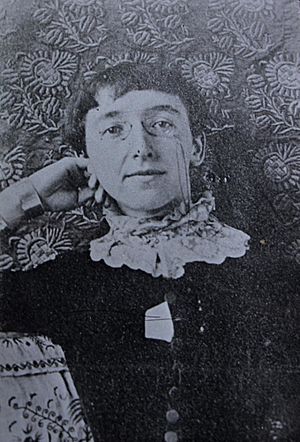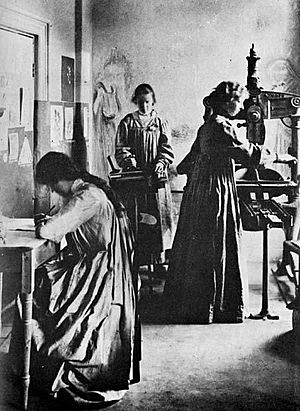Evelyn Gleeson facts for kids
Quick facts for kids
Evelyn Gleeson
|
|
|---|---|
 |
|
| Born | 15 May 1855 |
| Died | 20 February 1944 (aged 88) Dun Emer, Dundrum, Dublin, Ireland
|
| Occupation | designer |
| Known for | founder of Dun Emer Press |
Evelyn Gleeson (born May 15, 1855, died February 20, 1944) was a talented English designer. She created beautiful embroidery, carpets, and tapestries. Evelyn is famous for starting the Dun Emer Press with Elizabeth Yeats and Lily Yeats. This press was a special workshop where artists made books and crafts.
Contents
Evelyn's Early Life and Learning
Evelyn Gleeson was born on May 15, 1855, in Knutsford, Cheshire, England. Her father, Edward Moloney Gleeson, was an Irish doctor. Her mother was Harriet Simpson.
Evelyn's father saw many people without jobs in Ireland. So, in 1859, he started the Athlone Woollen Mills. This factory made wool products. In 1863, Evelyn's family moved to Athlone, Ireland.
Evelyn went to school in England. She first trained to be a teacher. Later, she studied how to paint portraits in London from 1890 to 1892. After that, Evelyn learned design from Alexander Millar. He was part of the Arts and Crafts movement. This movement focused on making beautiful, handmade items. Millar was very impressed with Evelyn's skill in mixing colors. Some of her designs were even bought by a carpet company in Glasgow.
Moving to Ireland and Starting Dun Emer
Evelyn Gleeson was very interested in Irish culture and history. She joined groups like the Gaelic League and the Irish Literary Society. She also knew the famous Yeats family and other artists in London. Evelyn was inspired by the exciting Gaelic revival in Irish art and writing.
She was also part of the movement that fought for women's right to vote. She led a women's club in London called the Pioneer Club.
In 1900, Evelyn saw a chance to help the Irish revival and women's rights in Ireland. A friend, Augustine Henry, suggested she move to Ireland for her health. He also offered her a loan of £500 to start her own craft center. Evelyn talked about her ideas with the Yeats sisters, Elizabeth Yeats and Lily Yeats. They were skilled craftswomen with many important friends. However, they did not have money to invest. Evelyn also spoke with William Butler Yeats, Jack Butler Yeats, and her cousin T. P. Gill.
In the summer of 1902, Evelyn found a good house in Dundrum, Dublin. She renamed the house Dun Emer. This name honored Emer, a legendary Irish woman known for her amazing craft skills. A printing press was set up in November 1902. Soon, three different craft workshops were started.
- Lily Yeats managed the embroidery section. She had learned from May Morris, a famous embroiderer.
- Elizabeth Yeats led the printing section. She had experience from a printing group in London.
- Evelyn Gleeson was in charge of weaving and tapestry. She also managed all the money for the studios.
William Butler Yeats was the group's advisor for writing. This sometimes caused disagreements.
Dun Emer's Work and Growth
The Dun Emer studio hired and trained local girls. They focused on using high-quality Irish materials. Their goal was to create beautiful, fancy, and long-lasting handmade objects. Their statement in 1903 said: "Everything as far as possible is Irish… The designs are also of the spirit and tradition of the country." By 1905, the workshop employed 30 women and girls.
Many of their orders came from the Catholic Church. For example, Loughrea cathedral ordered 24 embroidered banners in 1902-1903. These banners showed Irish saints. They also made church clothes, dresses, curtains, and cushions. These items often featured designs inspired by ancient Celtic art. The group's first published book was W. B. Yeats' In the seven woods in 1903. It had a cover made of Irish linen.
Evelyn Gleeson often judged craft competitions around Ireland. At one event in 1904, she praised the good work. However, she also pointed out that people needed more training in design. She gave talks on this topic. She wanted to show that craftwork was important, not just a hobby.
Over time, there were disagreements with the Yeats sisters. This might have been because Evelyn was worried about money. Even with grants, she wanted to pay back the loan from Augustine Henry. These disagreements led to the Yeats sisters not mentioning Evelyn in an interview about Dun Emer. Evelyn's teacher, Millar, said this was like "Hamlet without the prince."
Because of these issues, Dun Emer split in 1904. Evelyn Gleeson led the Dun Emer Guild Ltd. The Yeats sisters led Dun Emer Industries Ltd.
The two groups continued their work. They showed their crafts separately at events like the Royal Dublin Society shows. In 1907, the National Museum of Ireland asked the Guild to make a copy of a Flemish tapestry. This tapestry was shown in 1910. In 1906, the Guild won a silver medal at an exhibition in Milan, Italy.
By the late 1900s, the groups were competing. The Yeats sisters eventually left. They took their printing press to their home in Churchtown, Dublin. Evelyn Gleeson forgave their debt of £185. In return, they agreed not to use the name Dun Emer. They started their own company called Cuala Industries. This included an embroidery workshop and the Cuala Press.
Evelyn's Later Years
Dun Emer continued to do well. Evelyn worked on designs with her niece, Katherine (Kitty) MacCormack. She also worked with May Kerley, Augustine Henry's niece. In 1910, Evelyn became a founder of the Guild of Irish Art Workers. She became a master in 1917.
The workshops moved from Dundrum to Hardwicke Street, Dublin, in 1912. Evelyn's rugs, tapestries, and embroideries were inspired by early Christian designs. These designs often featured twisted patterns and animal shapes. The Church continued to be their main customer. Evelyn also hired a bookbinder named Norah Fitzpatrick and an actress named Máire Nic Shiubhlaigh.
Evelyn's widowed sister, Constance MacCormack, lived with her at Dun Emer. Constance's children, Grace, Kitty, and Edward, also lived there. Constance managed the household. Grace and Kitty worked with their aunt from a young age.
Some of Evelyn's important works include:
- A banner made in 1919 for the Irish Women Workers’ Union.
- A carpet given to Pope Pius XI in 1932. This was the year of the Eucharistic Congress.
Kitty worked with her aunt on other Dun Emer projects. These included tapestries for the Honan Chapel in Cork in 1917. They also made gold church clothes for St Patrick's church in San Francisco in 1923.
Evelyn Gleeson passed away on February 20, 1944, at Dun Emer. Kitty continued to run the Guild after her aunt's death. The last home of Dun Emer was a shop on Harcourt Street, Dublin. It finally closed in 1964.
Images for kids



